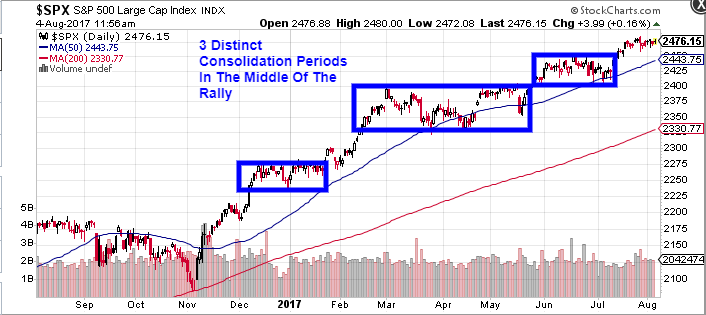The SPDR S&P 500 ETF Trust SPY 0.34% is up 10.5 percent so far in 2017, but traders paying attention in the last couple of weeks may have noticed that the stock market hasn’t been doing much moving at all lately. Since July 20, the S&P 500 has been range-bound between 2465 and 2485, never closing a session above or below those two levels.
Technical traders recognize the low-volatility sideways trading pattern as a consolidation period. Consolidation periods are periods of time when a stock or market takes a break from a prevailing trend and simply churns sideways or drifts in the opposite direction of the overall trend.
Markets rarely move in on direction for long, and even long-term bull market rallies or bear market sell-offs are typically filled with retracements and consolidation periods.
For any traders worried that the S&P 500 rally has run out of steam, there’s nothing sinister about the recent consolidation period at this point. In fact, it’s at least the fourth such consolidation period for the S&P 500 since the beginning of December.
A view of the one-year S&P 500 chart shows a clear rally from November’s low of 2083 to the index’s new all-time high of 2484 in July. However, the chart below breaks down several consolidation periods during that time in which the market made no meaningful move higher.

These periods can last anywhere from days to months at a time. But as long as the S&P eventually breaks out of the consolidation range to the upside, the bull rally is preserved.
So far, the current consolidation period is looking…
Click here to continue reading
Want to learn more about how to profit off the stock market? Or maybe you just want to be able to look sophisticated in front of your coworkers when they ask you what you are reading on your Kindle, and you’d prefer to tell them “Oh, I’m just reading a book about stock market analysis,” rather than the usual “Oh, I’m just looking at pics of my ex-girlfriend on Facebook.” For these reasons and more, check out my book, Beating Wall Street with Common Sense. I don’t have a degree in finance; I have a degree in neuroscience. You don’t have to predict what stocks will do if you can predict what traders will do and be one step ahead of them. I made a 400% return in the stock market over five years using only basic principles of psychology and common sense. Beating Wall Street with Common Sense is now available on Amazon, and tradingcommonsense.com is always available on your local internet!


